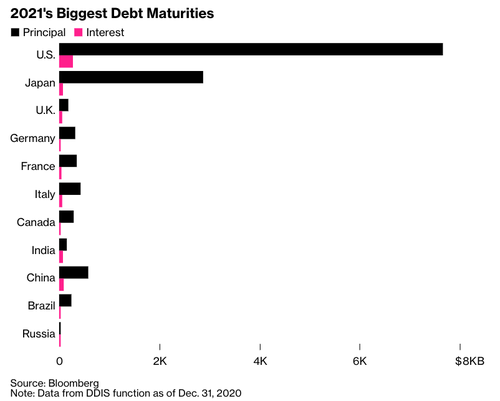
The world’s biggest economies shouldering record debt burdens are about to confront an unwelcome legacy of the financial crisis: a $13 trillion debt bill.
The Group of Seven nations plus key emerging markets face the heaviest bond maturities in at least a decade, much of them borrowings to dig their economies out of the worst slump since the Great Depression. According to data compiled by Bloomberg, these governments may need to roll over 51% more debt than in 2020.
The good news is that both central banks and investors are on their side. Policy makers facing lingering economic challenges from the pandemic are likely to stay accommodative — and keep borrowing costs low. Bonds remain a sought-after haven amid the virus’s rising toll on health and economies.
”Government debt ratios have exploded, but I believe that the short-term worrying over a rising debt is fruitless,” said Gregory Perdon, co-chief investment officer at Arbuthnot Latham. “Debt is leverage and assuming it’s not abused, it’s one of the most successful tools for growing wealth.”
2021’s Biggest Debt Maturities
Source: Bloomberg
Note: Data from DDIS function as of Dec. 31, 2020
Refinancing needs are the biggest in the U.S., with $7.7 trillion of debt coming due, followed by Japan with $2.9 trillion, according to Bloomberg data. China’s tab rises to $577 billion from $345 billion last year. In Europe, Italy has the heaviest bill of $433 billion, followed by France’s $348 billion. Germany has $325 billion due versus $201 billion last year. Not all these maturities will necessarily be extended by fresh borrowings.
To be sure, growth lift-off is still expected to translate into higher yields, with the median of economists surveyed by Bloomberg calling for a 10-year Treasury yield of 1.24% by the fourth quarter, from 0.93% currently.
Yet the onus remains on the world’s policy makers to keep rates low to foster the global economic recovery. The Federal Reserve is on pace to buy nearly half the $2 trillion of net supply TD Securities expects the U.S. government debt to issue this year.
In Europe, the result of central bank bond buying will help create a supply shortfall of 133 billion euros ($164 billion), according to Jefferies International.
“The practical reality is that debt levels and rates are linked, because most of the developed world cannot afford higher interest rates,” said Steven Major, the global head of fixed income research at HSBC Holdings Plc.
Read more: Ultra-Low Interest Rates Here to Stay: 2021 Central Bank Guide
— With assistance by Srinivasan Sivabalan, and Elizabeth Stanton
(Adds 10-year Treasury yield in sixth paragraph.)


Recent Comments